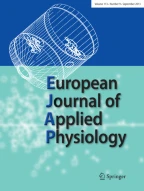Abstract
The aim of the present study was to examine the non-stationary mechanomyogram (MMG) during voluntary isometric ramp contractions of the biceps brachii muscles using the short-time Fourier transform, and to obtain more detailed information on the motor unit (MU) activation strategy underlying in the continuous MMG/force relationship. The subjects were asked to exert ramp contractions from 5% to 80% of the maximal voluntary contraction (MVC) at a constant rate of 10% MVC/s. The root mean squared (RMS) amplitude of the MMG began to increase slowly at low levels of force, then there was a slight reduction between 12% and 20% MVC. After that, a progressive increase was followed by a decrease beyond 60% MVC. As to the mean power frequency (MPF), a relatively rapid increase up to 30% MVC was followed by a period of slow increment between 30% and 50% MVC. Then temporary reduction at around 50% MVC and a further rapid increase above 60% MVC was observed. The interaction between amplitude and MPF of the MMG in relation to the MU activation strategy is discussed for five force regions defined on the basis of their inflection points in the RMS-amplitude/force and MPF/force relationships. It was found that the MMG during ramp contractions enables deeper insights into the MU activation strategy than those determined during traditional separate contractions. In addition, this contraction protocol is useful not only to ensure higher force resolution in the MMG/force relationship, but also to markedly shorten the time taken for data acquisition and to reduce the risk of fatigue.
Similar content being viewed by others
Author information
Authors and Affiliations
Additional information
Accepted: 31 August 2000
Rights and permissions
About this article
Cite this article
Akataki, K., Mita, K., Watakabe, M. et al. Mechanomyogram and force relationship during voluntary isometric ramp contractions of the biceps brachii muscle. Eur J Appl Physiol 84, 19–25 (2001). https://doi.org/10.1007/s004210000321
Issue Date:
DOI: https://doi.org/10.1007/s004210000321
